 NI recently announced a new Vector Signal Transceiver (VST) that goes to 44 GHz with 1 GHz of real-time bandwidth enabling production testing of 5G mmWave products. The mmWave VST integrates two bidirectional “IF” test ports covering a frequency range of 5 GHz to 21 GHz and up to two mmWave radio heads covering a frequency range of 22.5 GHz to 44 GHz. The radio heads are available in multiple configurations that provide 2 to 32 switched, bidirectional ports to address a wide array of high-frequency components and systems for 5G New Radio (NR) at new test points along the signal chain.
NI recently announced a new Vector Signal Transceiver (VST) that goes to 44 GHz with 1 GHz of real-time bandwidth enabling production testing of 5G mmWave products. The mmWave VST integrates two bidirectional “IF” test ports covering a frequency range of 5 GHz to 21 GHz and up to two mmWave radio heads covering a frequency range of 22.5 GHz to 44 GHz. The radio heads are available in multiple configurations that provide 2 to 32 switched, bidirectional ports to address a wide array of high-frequency components and systems for 5G New Radio (NR) at new test points along the signal chain.
Addressing the technical challenges associated with 5G mmWave wafer probe test, NI demonstrated a solution can help semiconductor manufacturers reduce their risk, cost and time to market for 5G mmWave ICs. NI, TEL, FormFactor and Reid-Ashman collaborated to demonstrate a direct dock probe solution that simplifies the signal path, provides the necessary signal integrity for mmWave applications and supports both top and bottom load probe applications. A key element of the solution is the NI Semiconductor Test System (STS), and NI recently demonstrated a multisite mmWave test solution for 5G power amplifiers, beamformers and transceivers.
NI/AWR discussed how the race to commercialize the many forms of 5G—faster broadband, mobility, and the Internet of Things (IoT)—is compelling RF, microwave, and millimeter-wave researchers and practitioners to take a smarter approach to microwave design and test. This new approach involves rethinking workflows. When development occurs in silos, information is not adequately shared across organizations. The NI software-defined platform prevents development in isolation by empowering teams to streamline concept-to-production workflows with interoperable software, such as the NI AWR Design Environment and LabVIEW. With these tools, organizations can accelerate product development, meet new and evolving test requirements, and manage aggressive time-to-market and schedule pressures. Demonstrations in the booth highlighted key features and applications such as:
- MMIC/RFIC, Module, & PCB Design Flows
- RF Amplifier & Filter Design
- 5G, IoT, & Radar Systems Design
- EM Analysis & Antenna Design
NIC introduced Thin Film Filters that span from 1 to 20 GHz with a bandwidth span of 1%-60%. These high-performance filters are built on industry standard substrates such as alumina and titanate and are offered in a compact package size with low profile of < 0.075 inches. Custom designs are available to meet a wider range of environmental requirements. They also introduced a low profile, high-performance 4 channel Switched Filter Bank that covers a wide frequency range from 1 to 18 GHz. This Switched filter Bank uses a combination of Thin film filters and LC filters along with Pin-diode switches and is TTL compatible. The filter bank offers low VSWR, excellent passband flatness, fast switching speeds, and is housed in a compact, low profile ruggedized enclosure.
NoiseWave announced the NW1G18-LM miniature calibrated noise source which was displayed at the show. The NW1G18-LM features broadband frequency coverage from 1 to 18 GHz. Designed in an industry standard small package, 0.53x0.62x0.25 in excluding field replaceable connectors, the device offers a minimum of 25 dB ENR with spectral flatness of +/- 1.25 dB. The unit operates from +15 Vdc and typically draws less than 15 mA. Custom models are also available. Ideal for built-in test integration include noise figure measurement, dithering for increased dynamic range of A/D converters and as an economical source of broadband power and signal to noise ratio testing. The NW1G18-LM is ideal for wireless test applications and covers all major wireless and CATV applications.
Norden Millimeter offers converters and transceivers for military and commercial applications including 5G, Airborne, UAV and EW. Norden offers COTS models for quick to market solutions and provides custom designs which utilize proven, low risk solutions. Its products operate in frequency bands from 500 MHz to 110 GHz. Features which can be included are temperature compensation, variable gain, internal LO and matched phase between channels. Norden products have passed stringent environmental test conditions and provide operating temperature ranges -55C to +85C. Their state-of-the-art NUDC2-18/1.3-2.3 is a dual conversion Transceiver providing 2-18 GHz operation in a versatile low-SWaP 3U VPX module. The NUDC2-18/1.3-2.3 includes internal LOs which provide an instantaneous IF bandwidth of 1 GHz and exceptional Noise Figure. Norden can customize the NUDC2-18/1.3-2.3 for your specific requirements.
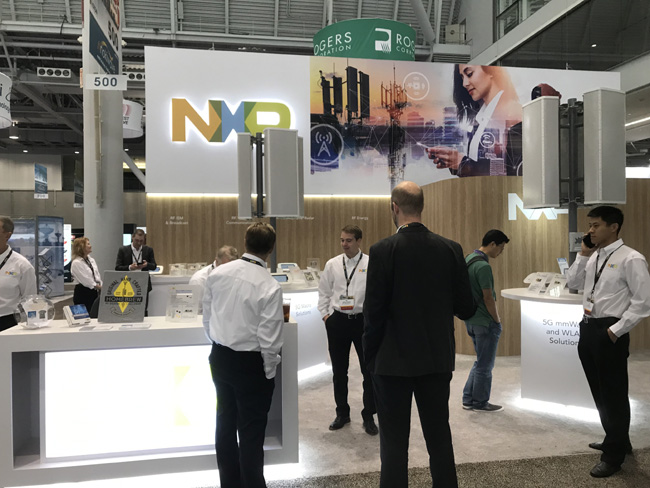 NXP introduced a family of LDMOS multi-chip modules (i.e., board products) for 5G massive MIMO systems. Each board contains an individually packaged PA, pre-driver, LNA and circulator. The boards have the same input and output and bias pins for all the power levels and frequency bands, i.e., 33 to 39 dBm average output power and 2.3 to 4.5 GHz. This common footprint simplifies base station design and shortens the development cycle for the range of cellular frequency bands. The PA, pre-driver and LNA ICs are also available separately for customers designing their own boards. Interestingly, NXP remains committed to LDMOS for the massive MIMO application — even to 4.5 GHz.
NXP introduced a family of LDMOS multi-chip modules (i.e., board products) for 5G massive MIMO systems. Each board contains an individually packaged PA, pre-driver, LNA and circulator. The boards have the same input and output and bias pins for all the power levels and frequency bands, i.e., 33 to 39 dBm average output power and 2.3 to 4.5 GHz. This common footprint simplifies base station design and shortens the development cycle for the range of cellular frequency bands. The PA, pre-driver and LNA ICs are also available separately for customers designing their own boards. Interestingly, NXP remains committed to LDMOS for the massive MIMO application — even to 4.5 GHz.
For mmWave base stations, NXP has developed 4-channel beamforming ICs fabricated with its internal SiGe process. Each channel contains a PA, LNA, T/R switch and vector modulator, for amplitude and phase control. NXP’s SiGe process delivers around 19 dBm compressed output power and better than 2 percent EVM when backed off to normal operating power. NXP argues their SiGe process provides the best system cost and DC power consumption compared to mmWave arrays fabricated with either SOI or GaN front-ends. To demonstrate the end application, NXP was displaying one of the company’s SiGe front-ends integrated with a Gapwaves mmWave antenna array.
NXP has not abandoned GaN, introducing what it says is the first solid-state device that beats the efficiency of a magnetron: a 330 W, 50 V GaN on SiC transistor with 73 percent efficiency at 2.45 GHz — 5 points better efficiency than the company’s best LDMOS transistor. This new GaN product is being marketed for commercial cooking, industrial, medical and other RF energy applications.
Ophir released a line of 6 to 18 GHz broadband amplifiers with powers ranging from 10 to 200 W. The 5304050 is a 10 Watt broadband amplifier that covers the 6 to 18 GHz frequency range and is small and lightweight. It utilizes Class AB linear GaN devices that provide an excellent 3rd order intercept point, high gain, and a wide dynamic range.
Optenni Lab RF Design Automation Platform has introduced antenna array analysis capabilities with the recently released version 4.3. By incorporating the per-port radiation pattern data as well as the full S-parameter matrix of the array, Optenni Lab is now able to accurately and efficiently evaluate active reflection coefficients, system efficiencies and beam properties of the array without the need for analytical approximations. The analysis can also include matching circuits composed of discrete inductors and capacitors or transmission lines. With the help of Optenni Lab, the designer can easily verify the performance of full array in different feeding configurations.
On Wednesday of IMS Week, Dr. Ryan C.C. Chin, CEO and Co- founder, Optimus Ride Inc. spoke at the MTT-S Awards Banquet. For a few hours leading up to the talk, we had the opportunity to see the Optimus Ride on the show floor. Optimus Ride Inc. is a leading self-driving vehicle technology company developing systems for geo-fenced environments. Emerging from Boston’s vibrant robotics ecosystem, they bring together the promise of self-driving technologies with real world considerations. The design of their software enables efficient, sustainable, and equitable mobility networks.
With roots at the Massachusetts Institute of Technology (MIT), Optimus Ride combines over thirty years of interdisciplinary research in self‑driving technologies (DARPA Urban Challenge), electric vehicles (MIT CityCar), and Mobility-on-Demand Systems. Its technology expertise and industrial experience combines manufacturing robots, urban design, and on-demand vehicle fleet management.

Pasternack continues to add to its RF coax adapter line-up with new 1.0mm, 1.85mm, 2.4mm 2.92mm, SMP, Mini SMP and 4.3/10 adapters to address the growing need for 5G and mmWave R&D, testing and production applications. These high frequency adapters feature precision manufactured construction and high quality materials and support frequencies up to 110 GHz (model dependent). In-series as well as between-series connector options are offered and both in-line and right-angle options are available for most series. Additionally, the vast majority of these adapters are REACH and RoHS compliant. All of Pasternack’s high frequency adapters and in stock and available for immediate shipment.
Pentek introduced several enhancements to its Navigator Design Suite for the Xilinx Zynq UltraScale+ RFSoC. New IP expands Pentek's existing IP library to over 140 cores for FPGA development on its Quartz Architecture platform. Pentek's Navigator Design Suite includes the Navigator FDK (FPGA Design Kit) for integrating custom IP into Pentek factory-shipped designs and the Navigator BSP (Board Support Package) for creating host applications. Starting with the FDK, new cores support the RFSoC on-chip A/D and D/A converters with the following new features. Data acquisition and waveform generator cores have been updated that include support for VITA 49.2 VITA Radio Transport (VRT) packet formatting. A new optimized x16 decimation core extends the range of the built-in RFSoC decimation. Pentek's Smart A/D Calibration feature adds hardware, FPGA IP and software to make Xilinx's calibration circuitry more robust across diverse operational scenarios. The programmable signal synthesizer core now includes a programmable frequency sweep generator, ideal for generating radar chirp pulse waveforms. These new cores for Quartz support operation of all eight RFSoC A/D and D/A converters simultaneously. In addition to data converter support, the Navigator core library now includes 100 gigabit Ethernet UDP engines, each moving data in both directions at 12 GBytes/sec through on-board optical interfaces. The Quartz board's optical interface supports up to two 100 gigabit Ethernet connections providing a total transfer rate of more than 24 GBytes/sec.
Pixus Technologies discussed how as the Microwave/RF industry moves to more open standard architectures, prototyping/test systems will be required for fast and efficient product development. Pixus displayed one of their new VITA 67 open frame test/dev chassis for OpenVPX. The VITA 67 specification defines RF signaling across the open standard backplane architecture. The versatile Pixus chassis allows either 3U or 6U boards of various configurations to be tested.
Pixus also displayed a rugged Software Defined Radio (SDR) based on X310 from Ettus Research, a National Instruments brand. The weatherproof, rugged enclosure features IP67 sealing for water and dust ingress. The Pixus RX310 contains two extended bandwidth daughterboard slots covering 10 MHz – 6 GHz with up to 160 MHz of baseband bandwidth, dual 1/10 GigE high-speed interfaces, and a large user-programmable Kintex-7 FPGA. The RX310 series can be used in various types of airborne, shipboard, ground vehicle, or outdoor designs.
 Planar Monolithics Industries had on display model P16T-100M52G-100-T-DEC which is a 0.1 to 52.0 GHz, SP16T Absorptive Switch. This model offers a typical insertion loss of 16 dB while maintaining a typical isolation of 70 dB. PMI displayed Model No. PS-2G18G-360-8D which is a 2.0 to 18.0 GHz, 8-Bit, Vector Phase Shifter making that is ideal for frequency translation where continuous monotonic phase shifting is required. This model also features high speed switching, and typically lower than 60 dB harmonic distortion. Other specifications include Insertion Loss: 18.0 dB maximum, Phase Shift Range: 360°, Switching Speed: 500 ns Max - Measured 410 ns, Control Slopes: Linear, Phase Vs Frequency: ±15° Typical - Measured ±15.39°, RF Input Power: +20 dBm CW, 1 W maximum, VSWR: 2.2:1 maximum - Measured 1.79:1 (50 Ohm System) and Power Supply: ±12 V to ±15 V @ ±100 mA maximum, Measured +15V @ 63 mA, Measured -15V @ 76 mA. Unit size is 4.25" x 3.50" x 1.00" with SMA (F) RF Connectors and DC-37P, Sub Miniature D Multi-Pin Control & Power Connector.
Planar Monolithics Industries had on display model P16T-100M52G-100-T-DEC which is a 0.1 to 52.0 GHz, SP16T Absorptive Switch. This model offers a typical insertion loss of 16 dB while maintaining a typical isolation of 70 dB. PMI displayed Model No. PS-2G18G-360-8D which is a 2.0 to 18.0 GHz, 8-Bit, Vector Phase Shifter making that is ideal for frequency translation where continuous monotonic phase shifting is required. This model also features high speed switching, and typically lower than 60 dB harmonic distortion. Other specifications include Insertion Loss: 18.0 dB maximum, Phase Shift Range: 360°, Switching Speed: 500 ns Max - Measured 410 ns, Control Slopes: Linear, Phase Vs Frequency: ±15° Typical - Measured ±15.39°, RF Input Power: +20 dBm CW, 1 W maximum, VSWR: 2.2:1 maximum - Measured 1.79:1 (50 Ohm System) and Power Supply: ±12 V to ±15 V @ ±100 mA maximum, Measured +15V @ 63 mA, Measured -15V @ 76 mA. Unit size is 4.25" x 3.50" x 1.00" with SMA (F) RF Connectors and DC-37P, Sub Miniature D Multi-Pin Control & Power Connector.
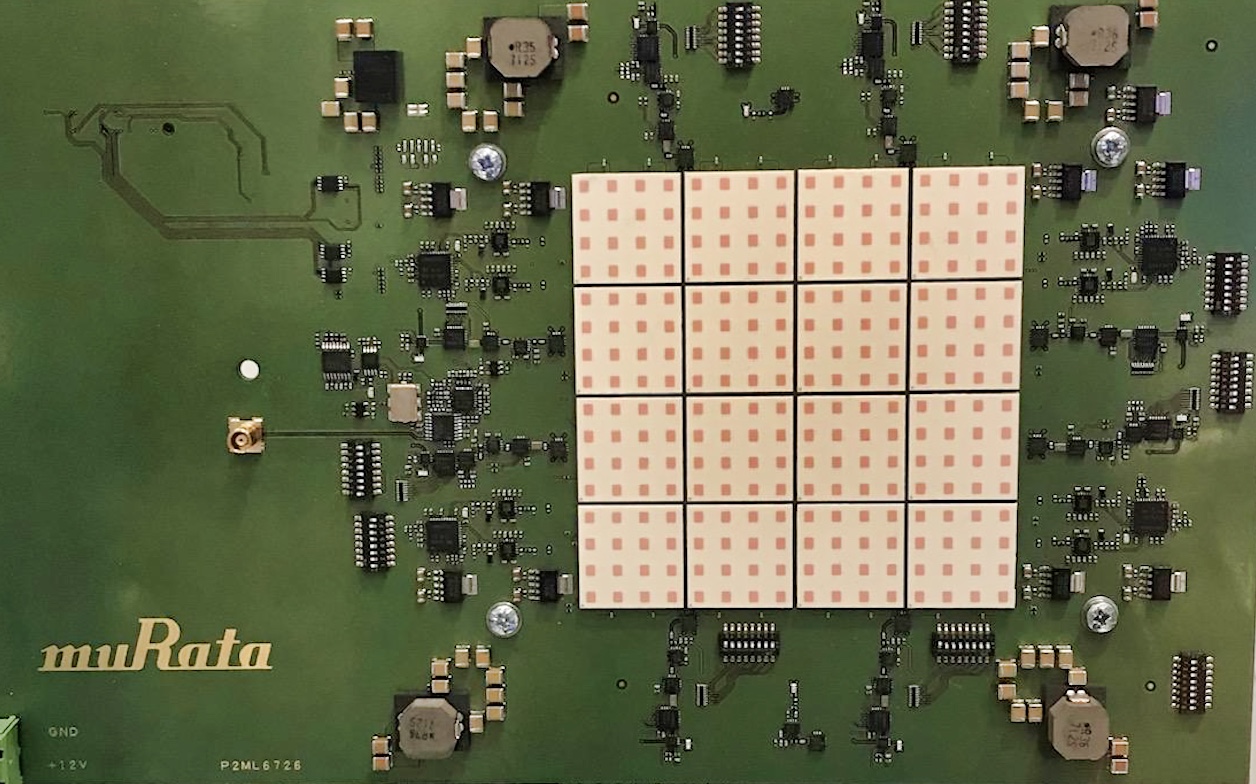 pSemi, Murata’s semiconductor center of excellence, announced the release of UltraCMOS® 13, the next-generation of its proprietary RFSOI process running on a GlobalFoundries’ 300 mm wafer fab. After several generations improving RonCoff, UltraCMOS 13 maintained that switch figure of merit at 80 fs and focused on improving LNA noise figure and PA linearity and efficiency, to enable the integration of sub-6 GHz front-ends for 5G. For the mmWave bands, pSemi and Murata have quietly been developing an antenna array leveraging Murata’s LTCC packaging technology with pSemi’s UltraCMOS process. While the company isn’t ready to formally announce a product, a 28 GHz 16 x 16 element prototype was publicly displayed, scaled from a 4 x 4 element unit cell driven by a single UltraCMOS beamformer IC.
pSemi, Murata’s semiconductor center of excellence, announced the release of UltraCMOS® 13, the next-generation of its proprietary RFSOI process running on a GlobalFoundries’ 300 mm wafer fab. After several generations improving RonCoff, UltraCMOS 13 maintained that switch figure of merit at 80 fs and focused on improving LNA noise figure and PA linearity and efficiency, to enable the integration of sub-6 GHz front-ends for 5G. For the mmWave bands, pSemi and Murata have quietly been developing an antenna array leveraging Murata’s LTCC packaging technology with pSemi’s UltraCMOS process. While the company isn’t ready to formally announce a product, a 28 GHz 16 x 16 element prototype was publicly displayed, scaled from a 4 x 4 element unit cell driven by a single UltraCMOS beamformer IC.
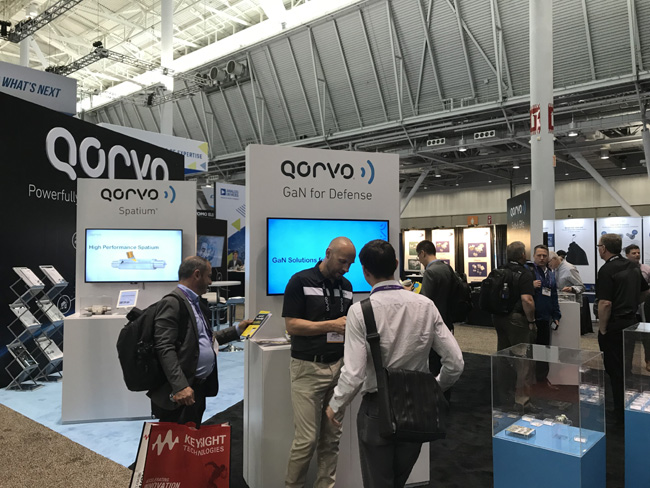 Qorvo launched two new GaN PA families for domestic and international Ka-band satcom and X-band phased array radar applications. The QPA2212 for Ka-band applications has industry leading linearity for wideband multi-carrier systems. The PA delivers 20 W of RF power operating over the 27 to 31 GHz frequency band. The QPA2212D is available now as die; packaged versions will be available in August 2019. The QPA1022 for X-band phased arrays offers best-in-class power added efficiency of 45% at 4 W RF power in the 8.5-11 GHz range. This is an increase in efficiency by 8% over previous products while providing 24 dB large signal gain. The QPA1022 is available to customers now in packaged and die versions.
Qorvo launched two new GaN PA families for domestic and international Ka-band satcom and X-band phased array radar applications. The QPA2212 for Ka-band applications has industry leading linearity for wideband multi-carrier systems. The PA delivers 20 W of RF power operating over the 27 to 31 GHz frequency band. The QPA2212D is available now as die; packaged versions will be available in August 2019. The QPA1022 for X-band phased arrays offers best-in-class power added efficiency of 45% at 4 W RF power in the 8.5-11 GHz range. This is an increase in efficiency by 8% over previous products while providing 24 dB large signal gain. The QPA1022 is available to customers now in packaged and die versions.
Qorvo also unveiled a MMIC power amplifier that delivers more than 10 W of saturated power over the 32 to 38 GHz band. The TGA2222 provides 16 dB of large-signal gain, 25 dB small-signal gain and an industry-leading power-added efficiency greater than 22%. It delivers this extended RF power in a smaller die, which reduces size, weight and number of components to create a simple but powerful solution for radar and electronic warfare applications.
Qorvo teamed up with Gapwaves to introduce a 28 GHz band phased array solution with 15% bandwidth, 24 dBi gain and better than +/-60 degree azimuth scanning. Gapwave supplies the waveguide based low loss 64 element antenna array which is paired with Qorvo's GaN front end modules and other components to produce an integrated array with 56 dBm EIRP. It can easily be scaled for higher powers and is aimed at macro cells, hot spots, fixed wireless access and other similar applications.
Finally, Qorvo announced new power-efficient, small cell front-end solutions for the sub-6 GHz wireless infrastructure market. The products significantly boost efficiency, enabling base station manufacturers to enhance existing 4G LTE infrastructure with greater bandwidth, coverage, throughput and capacity – particularly in high-density, high-traffic areas. The new Qorvo solutions include the Band 3 QPA9903 PA, the Band 8 QPA9908 PA, and the QPL9098 4-6 GHz bypass ultra-low noise amplifier. The PAs offer 34% PAE, enabling Power over Ethernet (PoE) small cell architectures targeted for deployments in high-traffic areas, such as subways, train stations, and stadiums or for high quality of service (QoS) enterprise in-building applications.
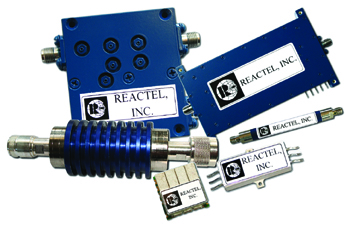 Reactel is Celebrating its 40th Anniversary, Reactel featured its full line of Filters, Multiplexers & Multifunction Assemblies covering up to 50 GHz. Supporting Military, Commercial, Industrial, Medical and Research needs, they can design a unit that is right for you. They were featuring their discrete component filters that can satisfy a variety of filter requirements. These versatile units cover the broad frequency range of 2 kHz to 5 GHz, and are available in either tubular or rectangular packages, connectorized or surface mount, and standard or high power versions. All standard discrete component filters utilize a low ripple Chebyshev design which offers the best compromise of low loss, low VSWR, and high selectivity. Each filter situation is unique, and the data provided on the following pages offers only a small glimpse of our capabilities. Should a different design become necessary to meet your requirements, we can provide these units with Bessel, Butterworth, Elliptic, Gaussian or Linear Phase responses. Please contact the factory for filters designed to your unique requirement.
Reactel is Celebrating its 40th Anniversary, Reactel featured its full line of Filters, Multiplexers & Multifunction Assemblies covering up to 50 GHz. Supporting Military, Commercial, Industrial, Medical and Research needs, they can design a unit that is right for you. They were featuring their discrete component filters that can satisfy a variety of filter requirements. These versatile units cover the broad frequency range of 2 kHz to 5 GHz, and are available in either tubular or rectangular packages, connectorized or surface mount, and standard or high power versions. All standard discrete component filters utilize a low ripple Chebyshev design which offers the best compromise of low loss, low VSWR, and high selectivity. Each filter situation is unique, and the data provided on the following pages offers only a small glimpse of our capabilities. Should a different design become necessary to meet your requirements, we can provide these units with Bessel, Butterworth, Elliptic, Gaussian or Linear Phase responses. Please contact the factory for filters designed to your unique requirement.
 Remcom demonstrated its EM simulation software suite for complete end-to-end design of complex devices and wireless communication systems. Together, the products provide a comprehensive 5G solution, from system and antenna design through performance assessment in realistic, simulated environments, and planning for deployment in 5G networks.
Remcom demonstrated its EM simulation software suite for complete end-to-end design of complex devices and wireless communication systems. Together, the products provide a comprehensive 5G solution, from system and antenna design through performance assessment in realistic, simulated environments, and planning for deployment in 5G networks.
- MIMO and Array Design
- 5G Urban Small Cells
- Fixed Wireless Access
- Indoor Wireless Applications
New features in XFdtd simplify 5G antenna array design; performance metrics for 5G beam steering applications enable engineers to confidently prepare their devices for the challenging demands of 5G networks. Wireless InSite's ray-tracing capabilities determine multipath propagation through a 3D environment, including diffuse scattering at millimeter waves. MIMO techniques including antenna diversity, spatial multiplexing, and beamforming make Wireless InSite a powerful tool for determining whether a device will meet 5G performance requirements in a realistic operating environment.
 RF Lambda discussed how in recent years RF-Lambda has developed a new Beam Forming System production line. These systems cover a range of frequencies, from sub-GHz to 18 GHz, with a number of elements ranging from 16 to 64 to meet a variety of beam width requirements. All antenna systems have a built in T/R Module—with PA’s, LNA’s, and phase shifters. RF-Lambda combined its state-of-the-art design capability for both power amplifiers and transceivers into these phased array systems, creating devices that are higher power and higher sensitivity than market competition. The unit in the demonstration is their 6 to 18 GHz 4x4 element system. This system has an equivalent output power of over 1000 W with a noise figure below 3 dB. It was designed for jamming systems but can also be used for radar and communication applications. It can be easily extended to an 8 x 8 system for narrower beams and higher power as needed.
RF Lambda discussed how in recent years RF-Lambda has developed a new Beam Forming System production line. These systems cover a range of frequencies, from sub-GHz to 18 GHz, with a number of elements ranging from 16 to 64 to meet a variety of beam width requirements. All antenna systems have a built in T/R Module—with PA’s, LNA’s, and phase shifters. RF-Lambda combined its state-of-the-art design capability for both power amplifiers and transceivers into these phased array systems, creating devices that are higher power and higher sensitivity than market competition. The unit in the demonstration is their 6 to 18 GHz 4x4 element system. This system has an equivalent output power of over 1000 W with a noise figure below 3 dB. It was designed for jamming systems but can also be used for radar and communication applications. It can be easily extended to an 8 x 8 system for narrower beams and higher power as needed.
Response Microwave announced the availability of a new waveguide to coax adaptor for use in antenna Tx/Rx applications that will be featured at the show. The new model RMAD.BS.W137Nf operates over the 5.85-8.2 GHz band with typical electrical performance of 0.25 dB max insertion loss, and 1.10:1 max VSWR. Power handling is 50 W CW. The unit is operational over the -10° to +85° C range and mechanical package is 2.7 x 1.75 x 0.94 in with precision SS/P type N female connector and WR137 flange. Alternate bands and connectors are available on request.
RFIC launched two state-of-the-art MMIC SoC products for the advanced 5G Network. The first product in the ARNA series, Front End Beamformer, ARNAFE01 is a highly integrated MMIC covering 24-30 GHz RF band with complete solution for single front end beamforming for 5G, SATCOM phased array antenna system. The second product, ARNAUD01, Up/down converter MMIC chip which down or up converts RF, 24-30 GHz to or from much lower IF Bands, 2-6 GHz with LO multiplier chain in built.
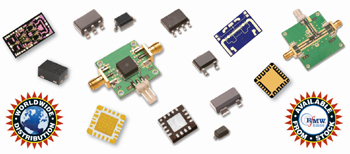 RFMW is the premier pure play technical distributor of RF & Microwave components, semiconductors, passive devices, RF interconnect and T&M accessories. On the IMS2019 show floor they highlighted high power GaN devices for 5G infrastructure and Aerospace & Defense from Qorvo, 5 GHz BAW filters from Akoustis, Ampleon amplifiers for RF Energy and Avionics, filter technologies to 60 GHz, 5G switching solutions, MEMS and crystal-based timing solutions, custom RF cable assemblies and more. They offer value add services and design solutions through a focused technical sales and marketing organization ready to support your RF component engineering efforts. From antenna to baseband, RFMW is your source for RF and Microwave solutions.
RFMW is the premier pure play technical distributor of RF & Microwave components, semiconductors, passive devices, RF interconnect and T&M accessories. On the IMS2019 show floor they highlighted high power GaN devices for 5G infrastructure and Aerospace & Defense from Qorvo, 5 GHz BAW filters from Akoustis, Ampleon amplifiers for RF Energy and Avionics, filter technologies to 60 GHz, 5G switching solutions, MEMS and crystal-based timing solutions, custom RF cable assemblies and more. They offer value add services and design solutions through a focused technical sales and marketing organization ready to support your RF component engineering efforts. From antenna to baseband, RFMW is your source for RF and Microwave solutions.
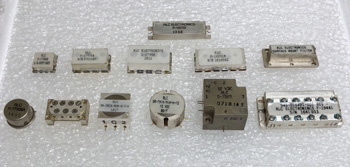 RLC Electronics continues to invest in its surface mount technology to add to its extensive capabilities across multiple product lines. Their surface mount electro-mechanical switch product enhancements include both SPDT and DPDT offerings, operating up to as high as 26.5 GHz. Units are offered in both Failsafe and Latching Operating Modes, and recent upgrades to the product line include the option of adding a TTL control or Indicator circuitry into our miniature package (0.625” x 0.625” x 0.40”). RLC’s continues to expand its surface mount filter line as well, offering lowpass, bandpass, highpass and notch filters in both pin style packages as well as PCB versions. Filter technology supports both low frequency (UHF) and L/S/C bands with lumped topology, as well as up to K-band with surface mount cavity technology.
RLC Electronics continues to invest in its surface mount technology to add to its extensive capabilities across multiple product lines. Their surface mount electro-mechanical switch product enhancements include both SPDT and DPDT offerings, operating up to as high as 26.5 GHz. Units are offered in both Failsafe and Latching Operating Modes, and recent upgrades to the product line include the option of adding a TTL control or Indicator circuitry into our miniature package (0.625” x 0.625” x 0.40”). RLC’s continues to expand its surface mount filter line as well, offering lowpass, bandpass, highpass and notch filters in both pin style packages as well as PCB versions. Filter technology supports both low frequency (UHF) and L/S/C bands with lumped topology, as well as up to K-band with surface mount cavity technology.
Rogers Corporation was featuring the new TC350™ Plus Materials that are printed circuit board substrates comprising PTFE, high thermally conductive ceramic fillers and woven glass reinforcement.TC350 Plus materials offer the designer a unique combination of lower loss tangent (and insertion loss) and higher thermal conductivity to enable superior reliability and reduced operating temperatures in high power applications.
Features
- High Z-Axis Thermal Conductivity (1.24 W/mK)
- LowTCDk(-42 ppm/°C, -40°C to 140°C)
- Low Planar X/Y CTE (10/9 ppm/°C)
- Low Z-Axis CTE (38 ppm/°C)
- Low Loss Tangent (0.0017 @ 10 GHz)
- Excellent mechanical drilling and routing performance
- Available in Large Panel Format up to 48” x 36”
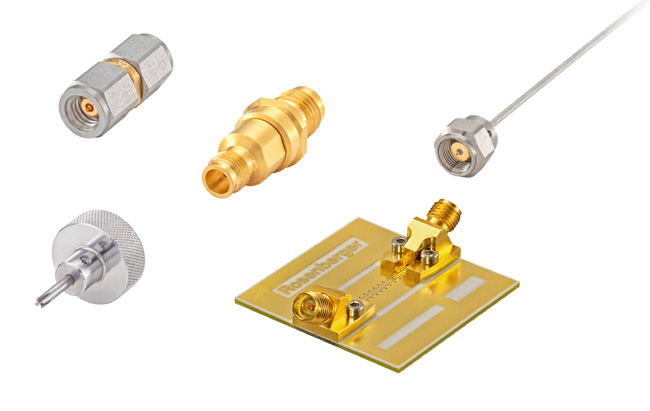 Rosenberger was featuring its new RPC-1.35 precision 1.35 mm connector series for test and measurement applications up to 90 GHz, specifically targeting new applications such as 5G, millimeter wave sensors for self driving automobiles, and WLAN 802.11ax and ay. Calibration kits are in development. This new connector series was specifically designed to have a highly robust mechanical design, minimum 3000 mating cycles, high connector repeatability, and maximum return loss values. It arose out of a working group made up of PTB (Physikalisch Technische Bundesanstalt), Rosenberger, Rohde & Schwarz, and Spinner GmBH & Co., which developed the concept of a new 1.35 mm connector to close the gap between 1.85 mm and 1.00 mm connectors for high-performance measurements in E-band. The interface standardization is still in progress. The Rosenberger booth also featured its solderless PCB connectors and an economical version of its new 75 ohm impedance calibration kits in versions spanning DC to 4 GHz, 4 to 8 GHz, and 8 to 12 GHz, which are now in distribution.
Rosenberger was featuring its new RPC-1.35 precision 1.35 mm connector series for test and measurement applications up to 90 GHz, specifically targeting new applications such as 5G, millimeter wave sensors for self driving automobiles, and WLAN 802.11ax and ay. Calibration kits are in development. This new connector series was specifically designed to have a highly robust mechanical design, minimum 3000 mating cycles, high connector repeatability, and maximum return loss values. It arose out of a working group made up of PTB (Physikalisch Technische Bundesanstalt), Rosenberger, Rohde & Schwarz, and Spinner GmBH & Co., which developed the concept of a new 1.35 mm connector to close the gap between 1.85 mm and 1.00 mm connectors for high-performance measurements in E-band. The interface standardization is still in progress. The Rosenberger booth also featured its solderless PCB connectors and an economical version of its new 75 ohm impedance calibration kits in versions spanning DC to 4 GHz, 4 to 8 GHz, and 8 to 12 GHz, which are now in distribution.
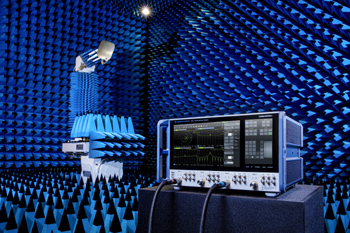 Rohde & Schwarz demonstrated the latest bench and field solutions for signal generation and analysis in the RF, microwave and millimeter wave range. Featured demos and new products include:
Rohde & Schwarz demonstrated the latest bench and field solutions for signal generation and analysis in the RF, microwave and millimeter wave range. Featured demos and new products include:
- 5G device characterization using the R&S®ATS1000 Antenna Test System
- Beamforming test solutions using the multi-port R&S®ZNBT Vector Network Analyzer
- The new high-end R&S®ZNA Vector Network Analyzer
- Wideband signal analysis with the R&S®FSW
- High sensitivity, pulse and additive phase noise measurements using the R&S®FSWP Phase Noise Analyzer and VCO Tester
- Wideband multi-channel signal generation with the R&S®SMW
- The performance leading R&S®SMA100B RF and Microwave Analog Signal Generator
R&S recently introduced the TSME30DC downconverter to extend 5G testing, the network scanners can analyze signals up to 30 GHz. The solution uses an updated version of the R&S ROMES4 drive test software, which already today supports measurements on 5G NR user equipment, e.g. evaluation boards, USB dongles and pre-commercial and commercial smartphones as they become available. This allows manufacturers of 5G NR technology to gain early insights into a device’s performance and its interaction with real 5G NR networks.
The R&S®ZNA highend vector network analyzer makes demanding measurements easier than ever and was another featured product. New to the market is the analyzer's DUT-centric operating concept, which guides users quickly and conveniently to the desired measurement setup. Two independent touchscreens provide utmost flexibility for smooth, efficient operation. The R&S®ZNA features exceptional stability, low trace noise and excellent raw data, making it a perfect choicefor development and production applications that require high accuracy, e.g. for developing and producing components and modules for A&D and satellite applications. The R&S®ZNA offers four internal, phase-coherent sources, allowing independent control of the signal's frequency at each port as well as phase measurements on mixers. It provides two internal local oscillators (LOs), a true multichannel receiver architecture, pulse modulators and comprehensive trigger and synchronization capabilities.
The R&S®ZNBT is the first multiport vector network analyzer offering up to 24 integrated test ports. The instrument can simultaneously test multiple DUTs or measure one DUT with up to 24 ports. The R&S®ZNBT offers short measurement times even in scenarios with a large number of ports. Other highlights include a wide dynamic range, high output power levels and inputs featuring high power-handling capacity. The instrument is available in two different frequency ranges: The R&S®ZNBT8 operates in a range from 9 kHz to 8.5 GHz, the R&S®ZNBT20, R&S®ZNBT26 and R&S®ZNBT40 from 100 kHz to 20 GHz, 26.5 GHz and 40 GHz, respectively. These features make the R&S®ZNBT ideal for applications in the mobile radio, wireless communications and electronic goods industries.
The R&S®SMA100B RF and microwave signal generator delivers maximum performance without compromise. It provides purest output signals while maintaining the highest output power level, far outpacing the competition. As the world's leading signal generator, it can handle the most demanding component, module and system T&M tasks in the RF semiconductor, wireless communications and aerospace and defense industries.
SAGE Millimeter now offers products for mmWave ATE setups that need to calibrate and test at different power levels. This need can be achieved by a highly repeatable programmable attenuator. It is a mechanical-based solution that handles 1W and reduces non-linearities in a super-high dynamic range setup. SAGE Millimeter’s instrumentation grade 2.4 mm Programmable Attenuator family encompasses these needs. Model STA-0005036010-2F2F-P7 covers DC to 50 GHz with attenuation levels between 0 to 60 dB in 10 dB steps. The operation is enabled by uC-disciplined inductive actuators, driven by a +24V voltage and 5V TTL control signals. The fast switching time, less than 25 ms, and long life, 1 million cycles per switch, makes this product and the others in SAGE’s Coaxial Programmable Attenuators family the perfect companion in complex ATE setups. It's also quite compact, measuring at only 3.5"x1.6"x0.9”.
Yonghui Shu, CTO of SAGE Millimeter, was enthusiastically demonstrating the Uni-Guide™ connector, an interface that simplifies the design of products requiring waveguide connections. The Uni-Guide interface connects to a glass bead in the housing wall and is bolted to the wall of the package. WR28, WR22 and WR19 versions are available for the common 12 mil diameter glass bead and 0.48 in. mounting hole interface, with other glass bead pin and mounting hole sizes available. The Uni-Guide portfolio covers waveguide interfaces from 8.2 to 110 GHz.
In October, Samtec announced it had acquired Precision Connector, Inc., and it was showing these products in its booth at IMS. For cabling products, Samtec highlighted the Bullseye high-density array test assembly products up to 70 GHz. They also were displaying a 1.2 mm connector for autonomous driving and a 1mm connector up to 110 GHz that is targeted for use in test equipment. Neither of these connectors has been released yet.
SemiGen was featuring their expanded capability to assist RF/microwave hybrid module manufacturers with our foundry requirements and thin film circuit manufacturing needs. Their ion beam milling technology is a dry etching thin film circuit manufacturing technique in which the ions of an inert gas are accelerated from an ion source into the surface of the substrate in order to remove the metals. The advantage of our thin film technology, is that it is anisotropic, resulting in minimum undercutting of the underlying metals during the etching process. This results in the best and most repeatable thin film traces and spaces, and excellent eutectic value and bond strength. They also offer wafer processing of 100 to 150 mm silicon wafers, and alumina (Al) and aluminum nitride (AlN) substrates up to 4.25 inches. Services include photolithography, wet etch, dry etch, metallization, grinding, polishing, and in-process metrology.
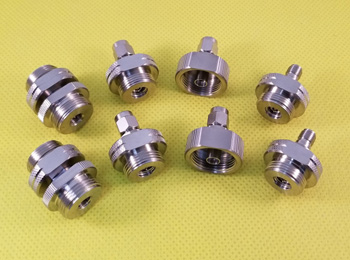 SGMC Microwaves introduced 2.4mm to 2.92mm between-series precision grade NMD connectors that are designed for use with microwave applications requiring excellent performance up to 40 GHz. NMD connectors are ruggedized test-port connectors that specially designed to stabilize the test port cable during testing on many network analyzers. The features include frequency range of DC to 40 GHz; Ruggedized construction for repeatability and reliability; Phase-matched adapters; Captivated Center Contact; Low VSWR and insertion loss; and available to ship same day from stock. SGMC offers an extensive line of precision in-series adapters, between-series adapters, receptacles, and cable connectors for various semi-rigid and flexible coaxial cables. Special designs are also available upon request.
SGMC Microwaves introduced 2.4mm to 2.92mm between-series precision grade NMD connectors that are designed for use with microwave applications requiring excellent performance up to 40 GHz. NMD connectors are ruggedized test-port connectors that specially designed to stabilize the test port cable during testing on many network analyzers. The features include frequency range of DC to 40 GHz; Ruggedized construction for repeatability and reliability; Phase-matched adapters; Captivated Center Contact; Low VSWR and insertion loss; and available to ship same day from stock. SGMC offers an extensive line of precision in-series adapters, between-series adapters, receptacles, and cable connectors for various semi-rigid and flexible coaxial cables. Special designs are also available upon request.
SignalCore featured their 6 GHz Single Channel Signal Sources: the SC5507A and SC5508A are from their PSG line of signal sources, providing tunable frequency range from True DC to 6.25 GHz, with resolution of 1 MHz. Its amplitude range is typically between -50 dBm to 15 dBm, stepping at 0.01 dB. The harmonics are typically < -35 dBc and the phase noise at 5 GHz CW is typically -125 dBc/Hz @ 10 kHz. These devices incorporate a 1MHz to 6 GHz power sensor with a measurement range from -25 and 15 dBm with accuracies of better than 0.50 dB. The signal purity, wide frequency range, large amplitude range, and power sensing make these devices ideal for applications ranging from digital clocking to LO sources, as well as in applications requiring stimulus and sense in a compact and rugged form factor.
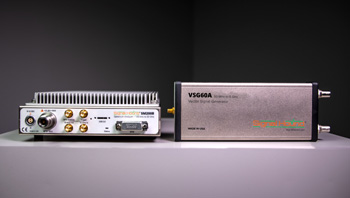 Signal Hound had two new products on display at IMS – the VSG60A vector signal generator (50 MHz - 6 GHz), and the SM200B high-performance spectrum analyzer, which tunes from 100 kHz - 20 GHz. The VSG60A vector signal generator is a small, pocket-sized device capable of producing many of the complex signals used in today’s ever-evolving wireless communications industry, featuring 40 MHz of streaming modulation bandwidth and an arbitrary sampling rate. The VSG60A connects to a Windows PC via USB and is controlled by software running on the PC.
Signal Hound had two new products on display at IMS – the VSG60A vector signal generator (50 MHz - 6 GHz), and the SM200B high-performance spectrum analyzer, which tunes from 100 kHz - 20 GHz. The VSG60A vector signal generator is a small, pocket-sized device capable of producing many of the complex signals used in today’s ever-evolving wireless communications industry, featuring 40 MHz of streaming modulation bandwidth and an arbitrary sampling rate. The VSG60A connects to a Windows PC via USB and is controlled by software running on the PC.
The SM200B is the next iteration of Signal Hound’s popular SM200A high-performance spectrum analyzer. Tuning from 100 kHz to 20 GHz with 1 THz sustained sweep speeds, a 20 MHz to 20 GHz sub-octave preselector, and 110 dB of dynamic range, the SM200B now offers 160 MHz of segmented I/Q capture for even more analysis capabilities.
Signal Integrity Inc. was showcasing its expertise in assisting customers to design test sockets and contact solutions, working with products from its standard library of probes or a customized probe. The company offers contact probes with pitches from 0.20 mm to 1.0 mm for high-speed digital and microwave application requirements. Typical end applications include matched impedance connectors, OEM devices, and miniature sub assemblies.
Skyworks was featuring their infrastructure solutions including SKY66313-11 wide instantaneous bandwidth, high efficiency power amplifier. It operates from 3.4 to 3.6 GHz with PAE of 15% at 23 dBm and has high linearity +23 dBm with less than -50 dBc ACLR with pre-distortion. It is packaged in a 5x5x1.3 mm, 16 pin package. They also featured their A&D products such as they SKYH22001 hermetically sealed broadband low noise amplifier operating from .3 to 3.8 GHz with a noise figure of 1.2 dB typical and the SKYH22002 hermetically sealed cascadable amplifier operating from .1 to 6 GHz with small signal gain of 20 dB typical at 2 GHz and OIP3 of +34 dBm typical.
Smiths Interconnect returned to IMS promoting its comprehensive product suite of board level components, cables, connectors, integrated microwave assemblies, time & frequency systems and antennas. Featured this year was the SpaceNXT™ Ku Series of high power WR75 circulators and loads. The newly released Ku-Band family of passive waveguide components is part of an overarching initiative to create a broad range of readily accessible connectors, cables, attenuators, waveguide isolators, circulators, terminations, transitions, hybrids and couplers pre-tested and qualified for space use.
 Southwest Microwave was showcasing its latest product, the industry’s first board (PCB) mounted 1.0 mm vertical launch connector. The connector delivers low insertion loss and a VSWR of 1.35:1 max across 70 to 105 GHz and a VSWR of 1.6:1 max across the complete 110 GHz bandwidth. (This data represents two 1.0 mm connectors mounted on test-board.) The company also offers 1.85 mm (V) DC to 67 GHz (VSWR 1.25:1 max) and 2.92 mm (K) DC to 40 GHz (VSWR 1.15:1 max) board-mounted vertical launch connectors. These connectors feature a common two-hole flange mounting footprint. (Connectors can be supplied with or without screws to accommodate for various PCB thicknesses.) The image here shows 2.92mm, 1.85mm, and 1.0mm versions.
Southwest Microwave was showcasing its latest product, the industry’s first board (PCB) mounted 1.0 mm vertical launch connector. The connector delivers low insertion loss and a VSWR of 1.35:1 max across 70 to 105 GHz and a VSWR of 1.6:1 max across the complete 110 GHz bandwidth. (This data represents two 1.0 mm connectors mounted on test-board.) The company also offers 1.85 mm (V) DC to 67 GHz (VSWR 1.25:1 max) and 2.92 mm (K) DC to 40 GHz (VSWR 1.15:1 max) board-mounted vertical launch connectors. These connectors feature a common two-hole flange mounting footprint. (Connectors can be supplied with or without screws to accommodate for various PCB thicknesses.) The image here shows 2.92mm, 1.85mm, and 1.0mm versions.
Wireless internet service provider Starry had a kiosk in the IMS start-up pavilion, demonstrating the start-up’s mmWave fixed wireless access technology. Starry, which uses spectrum in the 37–39 GHz band and recently won 24 GHz spectrum in the FCC’s Spectrum Frontiers auction, uses 802.11ac Wi-Fi for the radio link, rather than the 5G New Radio standard. Read Microwave Journal’s recent interview with Joe Lipowski, Starry’s co-founder and CTO.
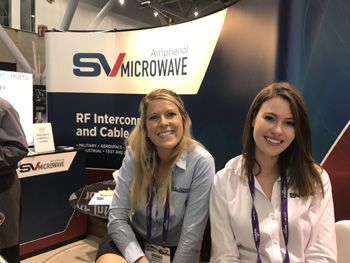 SV Micro's new Mini-D RF Connection System has industry leading .110” port-to-port spacing and uses removable SMPS bullets for high mating cycle applications without damaging the housing. SV’s low profile edge and surface mount PCB connector options are available with excellent RF performance through 67 GHz.
SV Micro's new Mini-D RF Connection System has industry leading .110” port-to-port spacing and uses removable SMPS bullets for high mating cycle applications without damaging the housing. SV’s low profile edge and surface mount PCB connector options are available with excellent RF performance through 67 GHz.
SV’s Mini-D RF features:
- High Frequency RF performance to 67 GHz
- High density design (.110” port-to-port spacing)
- Proven SMPS interface
- Rugged lightweight aluminum housing
- Easy mating/de-mating with thumbscrews
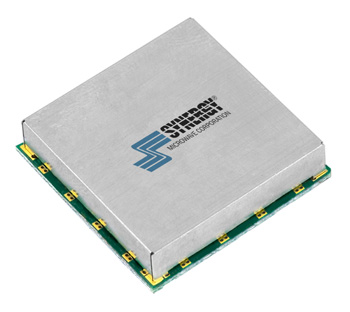 Synergy Microwave has developed new C- to K-Band Ultra-wide VCO with superior phase noise and high output power. They are packaged in surface mount 0.5” square packages operating with a Vcc of 5 volts. DCYS6001200-5 operates from 6 to 12 GHz with phase noise of -98 dBc/Hz at 100 kHz offset, DCYS8001600-5 operates from 8 to 16 GHz with phase noise of -93 dBc/Hz at 100 kHz offset and DCYS10002000-5 operates from 10 to 20 GHz with phase noise of -91 dBc/Hz at 100 kHz offset. Future models will be available up to 30 GHz.
Synergy Microwave has developed new C- to K-Band Ultra-wide VCO with superior phase noise and high output power. They are packaged in surface mount 0.5” square packages operating with a Vcc of 5 volts. DCYS6001200-5 operates from 6 to 12 GHz with phase noise of -98 dBc/Hz at 100 kHz offset, DCYS8001600-5 operates from 8 to 16 GHz with phase noise of -93 dBc/Hz at 100 kHz offset and DCYS10002000-5 operates from 10 to 20 GHz with phase noise of -91 dBc/Hz at 100 kHz offset. Future models will be available up to 30 GHz.
Teledyne Defense Electronics was joined by several Teledyne business units including Teledyne Labtech, Teledyne RF & Microwave, Teledyne TWT Products, Teledyne Relays, Teledyne Storm Microwave, Teledyne e2v Semiconductors Teledyne e2v RF Power – Defence, and Teledyne Scientific. The Featured Products in the booth covered many of Teledyne’s comprehensive MW/RF portfolio of advanced products and capabilities, including:
- First K-Band capable Digital-to-Analog Converter (DAC)
- New 1.35 mm cable connector to 90 GHz from Storm – the TSM SFO47EW
- Breakthrough PCB Thermal Management using copper coin technology from Labtech
- Amps, RF Modules, & Components with industry-leading SWaP from RF & Microwave
- Compact, high power Q and Ka-Band TWTs
- MPMs, compact Helix TWTs, Multifunctional MW Assemblies, and RF Receiver Protection
- New 5G RF Switches from Teledyne Relays
- InP power amps with leading BW and Efficiency from Teledyne Scientific
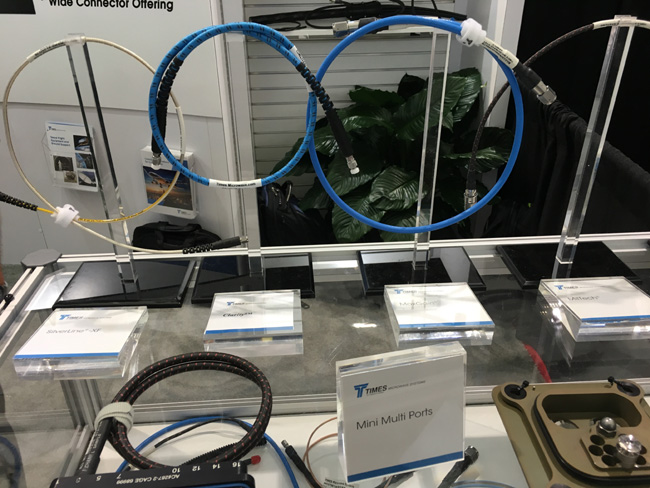 Times Microwave Systems featured its Clarity line of 18, 26.5, and 40 GHz coax test cables with steel torque, crush, and overbend protection with abrasion resistance, all while maintaining flexibility. One of the things that makes these cables special is that after 80,000 flexes, there is no change in electrical performance. The Clarity cables are available in armored and unarmored versions. The design includes an ergonomic, injection molded strain relief and Times’ SureGrip coupling nut that aims to improve the user’s everyday experience. The Clarity series is appropriate for use as VNA test port extension, R&D lab, production test, or system interconnect cables.
Times Microwave Systems featured its Clarity line of 18, 26.5, and 40 GHz coax test cables with steel torque, crush, and overbend protection with abrasion resistance, all while maintaining flexibility. One of the things that makes these cables special is that after 80,000 flexes, there is no change in electrical performance. The Clarity cables are available in armored and unarmored versions. The design includes an ergonomic, injection molded strain relief and Times’ SureGrip coupling nut that aims to improve the user’s everyday experience. The Clarity series is appropriate for use as VNA test port extension, R&D lab, production test, or system interconnect cables.
TMD Technologies showcased its latest microwave products featuring their state-of-the-art high-power sub-systems for radar, EW, and other defence/homeland security programs. Their latest instrumentation amplifier solutions for EMC, threat simulation, and other scientific applications will also be displayed. They will be showing their new line of Ka-band TWT MPMs, exemplified by the PTX8807, as well as the new lightweight PTXM2000 compact high power MPM, solid state PTS6900 and other ultra-compact TWT based MPMs from the PTXM Series.
- PTX8807 operates from 30-40 GHz with a power output of 200 W
- PTXM2000 operates from 6-18 GHz at 200 W
- PTX8815 TWTA covers 34–36 GHz with a peak power of over 1100 W in the mid-band, and 600 W at the band edges with a maximum duty of up to 12%
- PTS6900 MPM employs advanced GaN MMIC technology, and offers high performance over a 2-6 GHz range with an output power of 150 W
- Operating in the X-band, the new travelling wave tube based PTX8430 and PTX8501 have a power output of 1 kW over the frequency range 9-10 GHz with duty cycles of 5 and 10% respectively and 55 dB gain
- PTXM Series ultra-compact MPMs feature low volume and low and operate from 4.5 to 18 GHz with output powers up to 140 W
- PTCM Series TWT intelligent instrumentation amplifiers operate over a frequency range from DC to 40 GHz with a power output up to 50 kW
TowerJazz is a specialized silicon foundry for customized analog products, including RF, photonics and MEMS. Competing with GlobalFoundries for RF market share, TowerJazz offers RFIC designers RF SOI, RF CMOS and SiGe BiCMOS process nodes running on 200 and 300 mm wafers in multiple fabs, to assure customers of continuous supply. For example, the 65 nm RF SOI process provides designers with low insertion loss and high power handling RF switches, with options for LNA and digital integration. It ramped in a 300 mm fab in Japan one year ago. At IMS, TowerJazz staff met with potential customers to discuss how the company’s processes support LTE and 5G applications.
TRM featured the DL202 that is part of TRM’s line of 2-Way Ferrite Transformer Dividers and used in a variety of signal routing and processing systems for Early Warning Detection and Signal Exploitation in Military Airborne and Shipboard applications. Frequency range is 0.1 – 100 MHz, featuring high isolation and low loss. Lumped element based circuit technology allows for a compact housing to be applied for all frequency bands offered in the series. TRM will customizable to your spec requirements also.
UMS introduced a new 24.25-30.5 GHz multi-purpose integrated Power Front-End available in a 4x5 QFN low cost plastic package. This is particularly targeted for emerging 5G applications. This novel approach, gathering a high linearity RF transmitter, a switch and a very low noise RF receiver, is available in a standard plastic package. The Tx provides 33dB gain and exhibits 2W RF output power with 22% efficiency by using different technologies, 0.15µm GaN on Silicon carbide and 0.15µm GaAs. The Rx features 18 dB gain with a 3.5 dB Noise Figure. The circuit consumption is low at 3 W for 23 dBm Pout. This compact Front-End, perfectly suited for 5G fixed wireless access applications, is also compatible with telecom Phased Array Antennas, Time Division Duplex systems and high throughput fixed access wireless.
Vaunix announced the recent customization of their RF/microwave, solid-state, portable LMS signal generators to specifically support radar and location applications. The Lab Brick Model LMS-183CX is a high-performance, fast sweeping, digitally tunable RF/microwave test instrument that is USB powered and programmed via PC. The device provides test engineers working on broadband testing of components and systems dependable calibrated power control range of 80 dB, and 100 Hz frequency setting resolution. LMS-183CX Lab Bricks also offer low harmonic energy and are easily programmed for fixed frequency, linear frequency sweep (unidirectional or bidirectional at rates up to 20 MHz per μs), pulse modulation or chirp modulation. All controls are managed directly from the included graphical user interface (GUI). Alternatively, for users wishing to develop their own interface, Vaunix supplies LabVIEW drivers, Windows API DLL files, Linux drivers, Python examples and much more. Customized versions of the LMS-183CX Lab Brick signal generator can be specifically designed for unique radar receiver bandwidths with similar high-performance features.
 VDI introduced medium power waveguide amplifiers for WR12 (60 to 90 GHz) and WR4.3 (170 to 260 GHz) with WR 15 (50 to 75 GHz) in development. They have high gain and output power with full waveguide band coverage using a single bias voltage. Output power ranges from about 10 to 21 dBm with gains ranging from 15 to 21 dB. They also hosted the Vertigo and Guzik companies in their booth. Guzik was demonstrating accurate positioning using a D-Band system with parts from VDI.
VDI introduced medium power waveguide amplifiers for WR12 (60 to 90 GHz) and WR4.3 (170 to 260 GHz) with WR 15 (50 to 75 GHz) in development. They have high gain and output power with full waveguide band coverage using a single bias voltage. Output power ranges from about 10 to 21 dBm with gains ranging from 15 to 21 dB. They also hosted the Vertigo and Guzik companies in their booth. Guzik was demonstrating accurate positioning using a D-Band system with parts from VDI.
Velocity Microwave announced a full 12 years of support for their Vector line of repairable VNA cables. Every Vector cable is provided with an industry leading 2-year warranty. After the initial warranty, if your vector cable becomes worn or damaged, Velocity will provide a loaner cable to use until your cable is repaired and returned. The Vector loaner program gets you back up and running in the amount of time it takes to ship the loaner cable. All Vector repairs are provided at a flat rate of $450 so there is no guessing about the cost.
VIDA Products was demonstrating its high performance, low power, surface-mount, small size and low phase noise YIG oscillators and filters. VIDA integrates proprietary YIG resonators with RFICs to achieve YIG performance with lower power dissipation, smaller size and the convenience of surface-mount packaging. VIDA’s oscillators and filters support both commercial and defense systems operating at frequencies of 5 GHz and higher.
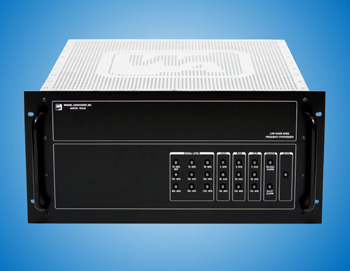 Wenzel Associates instruments combine industry leading Ultra-Low phase noise performance with standard 19” rack mount configurations (1U, 2U, 3U and 5U). A variety of standard rack source solutions are available with pre-configured output frequencies, but custom solutions are also available up to 8U. These units deliver superior performance at a lower cost than a variable low noise frequency synthesizer with the flexibility of providing only the fixed frequencies needed for requirement. Frequency outputs up to 26 GHz are available with Ultra-Low or Golden phase noise performance options are available. Multiple frequencies and multiple outputs are provided as needed as well as phase locking with an external reference. Each instrument includes a low noise power supply and/or low noise voltage regulators to help minimize power supply line related spurs, and provides clean power to drive the internal oscillators and modules.
Wenzel Associates instruments combine industry leading Ultra-Low phase noise performance with standard 19” rack mount configurations (1U, 2U, 3U and 5U). A variety of standard rack source solutions are available with pre-configured output frequencies, but custom solutions are also available up to 8U. These units deliver superior performance at a lower cost than a variable low noise frequency synthesizer with the flexibility of providing only the fixed frequencies needed for requirement. Frequency outputs up to 26 GHz are available with Ultra-Low or Golden phase noise performance options are available. Multiple frequencies and multiple outputs are provided as needed as well as phase locking with an external reference. Each instrument includes a low noise power supply and/or low noise voltage regulators to help minimize power supply line related spurs, and provides clean power to drive the internal oscillators and modules.
They were also featuring 10 and 100 MHz low noise PCB mount crystal oscillators with noise levels down to -178 dBc/Hz at 100 kHz offset. They certainly make some of the best oscillators in the industry and used as a reference signal in many high performance applications.
WIN Semiconductors, the largest compound semiconductor foundry, made two announcements at IMS, strengthening the company’s position supporting mmWave systems. Not to be overshadowed by silicon and GaN, WIN announced the commercial release of its highly integrated E-PHEMT process, PIH1-10. The PIH1-10 platform combines a 100 GHz ft E-PHEMT with monolithic PIN and Schottky diodes, which support all the circuit functions in a mmWave front-end for 5G handsets, base stations and radios for backhaul and fronthaul. The single supply E-PHEMT achieves transmit power levels of 30 dBm and receive noise figure of 2.5 dB, and the integrated PIN diode has less than 1 dB insertion loss.
WIN also announced the commercial release of a 0.15 μm GaN on SiC process, the NP15-00, for mmWave PAs operating to 35 GHz. The GaN device, which is designed to operate at 20 V, uses a source-coupled field plate to improve breakdown voltage. The process, which runs on 100 mm wafers, enables through-wafer vias for low inductance grounding. At 29 GHz, the GaN device achieves 3 W/mm saturated output power with greater than 50 percent efficiency — without harmonic tuning — and 13 dB linear gain.
The Wireless Telecom Group featured product demonstrations from their Boonton, Noisecom and CommAgility segments, highlighting how each addresses customer needs. With communication systems using complex modulation, single tone gain and output power measurements and two-tone linearity measurements are no longer sufficient to measure component and system performance. Buying vector signal generators and signal analyzers to replicate and measure actual OFDM signals can be expensive. Alternatively, using a Noisecom broadband noise source at the input, to simulate the modulated signal, and a Boonton peak power meter at the output is an elegant and comparatively inexpensive method for measuring and assuring system performance. The technique measures crest factor, which is more sensitive to the initial compression which quickly degrades system linearity and data throughput. To add insight, the crest factor measurement can include the complementary cumulative distribution function (CCDF), a probabilistic assessment of system performance.
W. L. Gore & Associates (Gore) played a key role in the Apollo 11 mission and featured their Apollo story and artifacts at IMS 2019 in addition to products for 5G and aerospace & defense testing. Gore’s contributions to space exploration began very early in its history. In just ten years, the company went from a Delaware basement where the company was founded in 1958, to the moon with multiple products contributing to the success of the July 1969 Apollo 11 moon landing. Gore wire and cable supported getting men to the moon, was involved in the seismographic experiments on the moon, and helped the astronauts to navigate back home.
Wolfspeed demonstrated two GaN on SiC power transistors in the company’s booth at IMS: a 35 W, X-Band, 50 Ω matched PA for radar applications and a 60 W average (400 W peak) device targeting the 3.6 to 3.8 GHz 5G band in Korea. Although Wolfspeed sees GaN as the RF growth engine, it maintains the LDMOS portfolio acquired with Infineon’s RF power business. Wolfspeed’s marketing strategy is to let the market requirements and customer choose the “best” technology fit for the application. Simon Wood, the senior director of RF product development and applications, said the lower frequency, single cellular band applications favor LDMOS, while the multi-band and higher frequency PAs favor GaN, where GaN’s cost is offset by eliminating several single-band PAs or through operator OPEX savings.
Xilinx discussed applications for the Zynq® UltraScale+ RFSoC, from 5G infrastructure to defense systems. The RFSoC platform builds on Xilinx’s leadership in FPGAs, adding direct sampling 5 GSPS, 14-bit ADCs and 10 GPSP, 14-bit DACs. Now in its third-generation, the UltraScale+ RFSoC covers the full sub-6 GHz spectrum, and mmWave spectrum can be block down-converted to use the performance of the RFSoC. For massive MIMO radios, Xilinx estimates the UltraScale+ architecture will consume 50 percent less power and occupy 75 percent less board area. The capability and flexibility of the platform makes it applicable for cable PHY and phased array radar.

